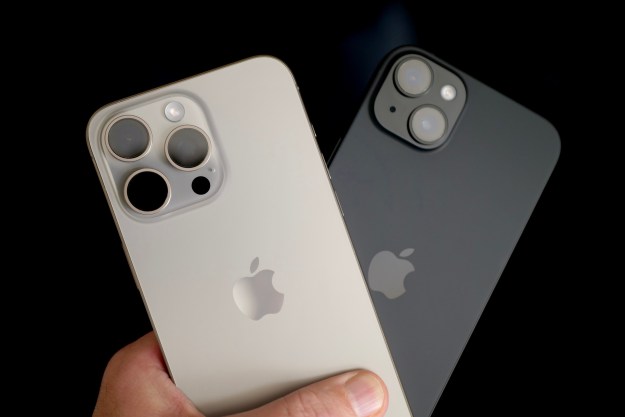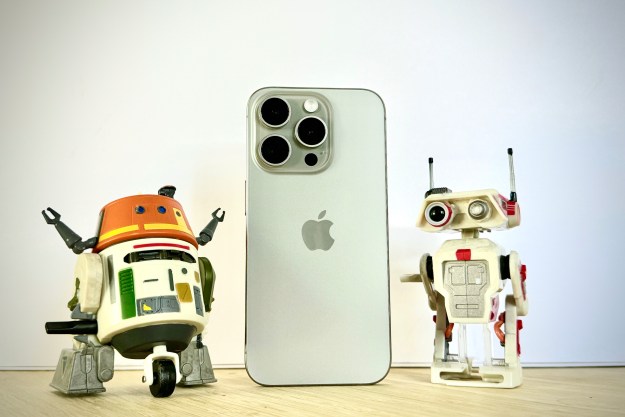Even before Tim Cook graced the stage for Apple’s big event on Tuesday, nearly everybody had a hunch Apple would announce the new iPhone 6 — as well as the Apple Watch. With the pomp and circumstance finished and the dust settled, Apple completely tore the veil off its new flagship and we no longer have to speculate about its specifications. Outfitted with a new operating system, an overhauled processor, improved camera, and larger size, the iPhone 6 impresses at nearly every turn.
Related: Hands-on with the new iPhone 6 and iPhone 6 Plus
Everyone already knows its an upgrade over its previous iteration, the iPhone 5S, but how does it stack up against the other top smartphones on the market? To help answer this question, we’re putting the iPhone 6 to the test against many leading smartphones. Up next is the LG/Google offering, the Nexus 5. Below you’ll find our side-by-side specification comparison, as well as what makes each phone unique and worthy of your hard-earned money. Take a look at who prevails in our iPhone 6 versus Nexus 5 spec showdown.
|
Apple iPhone 6  |
Google Nexus 5 |
|
| Size | 5.44 x 2.64 x .27 inches | 5.43 x 2.72 x .34 inches |
| Weight | 4.55 ounces | 4.58 ounces |
| Screen | 4.7-inch LCD | 4.95-inch LCD |
| Resolution | 1334 x 750 pixels | 1920 x 1080 pixels |
| OS | iOS 8 | Android 4.4 (KitKat) |
| Storage | 16, 64, 128GB | 16, 32GB |
| SD Card Slot | No | No |
| Processor | Apple 64-bit, A8 chip | Quad-core Snapdragon 800 |
| RAM | 1GB | 2GB |
| Connectivity | 4G LTE, 802.11ac | Wi-Fi, 4G LTE, HSPA+ |
| Camera | 8MP Rear, 2.1MP Front | 8MP Rear, 1.3MP Front |
| Bluetooth | Yes, version 4.0 | Yes, version 4.0 |
| Fingerprint sensor | Yes | No |
| NFC | Yes | Yes |
| Battery | TBA, 14 hours of talk time | 2300mAh, 17 hours of talk time |
| Charger | Lightning | microUSB |
| Marketplace | Apple App Store | Google Play Store |
| Avg. Price | $650, $200 with a two-year contract | $350, $100 with a two-year contract |
| Availability | September 19 on AT&T, Verizon, Sprint, T-Mobile | Now on T-Mobile, Sprint |
| DT Review | 4.5 out of 5 stars | 4 out of 5 stars |
Power and productivity
Not only does Apple’s newest iPhone pack an updated operating system, but the 6 boasts the new Apple 64-bit A8 processor. Mixed with the M8 motion coprocessor, the iPhone 6 sees a big jump over its A7-sporting predecessor, the iPhone 5S. For starters, the A8 operates 25 percent faster than the A7, sees a 50 percent jump in graphical performance, and is also 50 percent more power efficient. Not much outside of these statistics is relatively known about Apple’s new A8 chip, so comparing it to the Nexus 5’s Snapdragon 800 proves a difficult task. The Nexus 5 does come standard with 2GB of RAM, while it’s expected the standard version of the iPhone 6 will carry just 1GB of RAM giving LG’s model the slight advantage. Both are 4G and LTE compatible and both also feature NFC technology after Apple included it in its latest device.
Related: Everything we know about Apple’s new iOS 8
The iPhone makes the NFC function especially useful with the introduction of its easy-payment application, Apple Pay. Just upload any credit cards you have to the Apple Pay application, and you’ll have the ability to easily pay at any retail store or restaurant which uses NFC in its business. LG’s Nexus 5 runs the latest edition of Android’s KitKat operating system while Apple plans to unveil its long-awaited iOS 8 upon the launch of the iPhone 6.
Winner: iPhone 6
Design
When comparing the design specs of both the iPhone 6 and the Nexus 5 you’ll find them very similar of each other. Both stand about 5.4 inches tall, around 2.7 inches wide, and weigh no more than 4.5 ounces each. Though where the Nexus 5 has the slight advantage over Apple’s new flagship in terms of its screen resolution. Coming standard on the Nexus 5 is a 1920 x 1080 pixel screen resolution while the iPhone 6 has just a 1334 x 750 pixel resolution. Apple didn’t change much of its tried and true iPhone design, and even though it’s slightly bigger, Apple says it’s much easier to operate with one hand than other big phones. It also added another line of applications on the home screen, upping the total from five on the iPhone 5S/5C, to six on the the new iPhone 6. The Nexus 5’s home screen features a row of applications at the bottom, as well as its easy to use Google search bar at the top of the home screen.
Winner: iPhone 6
Camera
Another area where the two phones stack up nearly identically is in terms of each phone’s camera capabilities. The iPhone 6 touts an 8-megapixel rear facing camera to go along with a 2.1 megapixel front camera. The Nexus 5 on the other hand, also uses an 8-megapixel rear facing camera, though does trail Apple’s smartphone by only having a 1.3-megapixel front-facing camera. Aside from the uptick in megapixels for its front facing camera, Apple was hard at work to upgrade its iSight Camera, having improved its face detection, image stabilization, and auto-focus. Both phone’s shoot video in stunning 1080p HD and the iPhone 6 also sees the return slo-mo video and the ability to take still photos while recording. Apple’s advantage in the megapixel category, along with the welcomed improvements to the iSight Camera, give its camera the leg up on LG’s Nexus 5.
Winner: iPhone 6 (We think)
Price
Though the iPhone 6 costs $650, many cell phone retailers plan to offer the 6 at a discounted price if you decide to sign a two-year agreement. With a signed two-year agreement, you’ll have the option of picking up either a 16GB iPhone 6 for $200, a 64GB model for $300, or a massive 128GB model for $400. LG’s Nexus 5 is much cheaper. It is sold through T-Mobile, but you can buy it outright for $350 dollars, or about $300 cheaper than iPhone. The Nexus 5 is the best deal, by far.
Winner: Nexus 5 (by a long shot)
Conclusion
For anyone eligible for an upgrade with their respective cell phone carriers, it’s hard not to recommend picking up an iPhone 6 for $200. Users of other Apple products will find it even harder to avoid opting for the new iPhone 6 as Apple remains committed to providing a seamless connection between its phones and its computers or laptops. For those of you on the fence about your next smartphone venture, the Nexus 5 proves a worthy alternative to Apple’s flagship. Identical in regards to many specifications, we’d recommend the Nexus 5 to anyone looking to hop on the Android bandwagon. Though if we have to pick a winner, Apple’s new iPhone 6 looks poised to change the smartphone landscape yet again, and deserves the attention it’s garnered since the announcement.
Related: iPhone 6 vs. iPhone 6 Plus.
Related: iPhone 6 vs. Galaxy S5.
Related: iPhone 6 vs. Fire Phone.
Editors' Recommendations
- This one Apple Fitness feature completely changed how I exercise
- Best refurbished iPhone deals: Get an iPhone 14 for $513
- An Apple insider just revealed how iOS 18’s AI features will work
- 5 phones you should buy instead of the iPhone 15
- This is one of the cheapest 5G phones worth buying today



